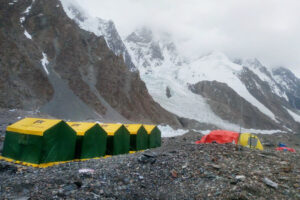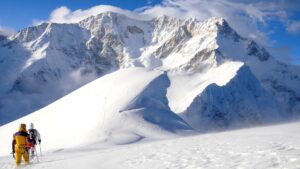Most contemporary adventure fans may not recognize the name of Aleister Crowley, but the self-styled Wickedest Man in the World was also arguably the best climber for a while. Then this mercurial man gave into his more peculiar leanings and strove to become a cult figure as an occultist and magician. He was also poet, painter and writer. His swashbuckling autobiography is quite the read.
Crowley endured a topsy-turvy early life that indelibly shaped the complex character he later became. His start was comfortable enough. Born in England in 1875 into relative affluence, thanks to his family’s inherited brewery business, things took a turn for the worse when his father died of tongue cancer when Alec (as Crowley was then called) was just 11. His beloved father’s death, mixed with the family’s all-consuming Christian fundamentalism (his parents were members of the Plymouth Brethren) marked a turning point in his life.
Over the next few years, he attended various devout boarding schools, where he rebelled with more than the usual adolescent acting-out, by indulging in such “sinful acts” as masturbation, spiking school meals, torturing animals and openly questioning the Bible. In an attempt to quell the wild teenager, his mother (whom Crowley claims called him “The Beast”) hoped a trip to Scotland’s mountainous Isle of Skye would help.
There, a chance meeting with Joseph Lister (of antispetic surgery fame), who was also a keen amateur climber, led to Crowley’s introduction to the mountains, in the form of the airy and rugged Cuillin Ridge — a classic among British mountaineers even today. At the same time, a personal tutor encouraged the clearly impressionable Crowley to indulge in smoking, drinking, sex and all other pleasures his fundamentalist upbringing had forbidden. These he was to pursue with the same vigor as climbing.
Within a few months, Crowley was outstripping his climbing mentors. In what became characteristic, he crowed insufferably about his exploits, in the belief that he was already superior to the gentlemanly amateurs that were the order of the day. By age 19, in 1894, he was already a member of prestigious the Scottish Mountaineering Club, and was building a strong climbing CV.
This included making improbable ascents of various routes on a perilous and unprotectable chalk cliff named Beachy Head in the South of England, the hardest of which was later graded close to 5.9/5.10 (HVS/E1 in British money). Such technical difficulty was decades ahead of his peers at the time, and quite risky, given the fragile nature of chalk. “One does not climb the cliffs,” Crowley wrote at the time. “One hardly even crawls. Trickles or oozes would perhaps be the ideal verbs.” Climber and writer Geoff Powter suggests that his success was largely due to his high tolerance for risk.
Around the same time, Crowley went back and forth to the Alps, making fast ascents of classic testpieces like the Eiger, Monch and Jungfrau, as well as bagging first ascents of lesser peaks. An inheritance of nearly $20 million allowed such freedom of travel, as well as long summer holidays from his studies at Cambridge University, where he also dabbled in drugs, alternative art, literature and Eastern mysticism. His sojourns abroad enhanced his reputation in the British climbing community, but he was blackballed by the Alpine Club for constantly sneering at his peers.
Crowley was also active in English Lake District climbing in the 1890s, doing a hard solo route on a classic feature known as Napes Needle, and he also targeted a “last great problem” on the same pinnacle of rock.
By 1898, Crowley was well-entrenched in the world of Dark Magic and in an ancient order known as The Golden Dawn (you can read more on this murky world here). Nevertheless, he continued to climb and happened upon a like-minded partner with similarly stratospheric ambitions in the mountains — the English climber Oscar Eckenstein, who also had an infamous reputation because of his similarly brash and condescending ways. After a couple of years of teaming up to blitz the Alps and several high mountains in Mexico, Eckenstein hatched the ambitious plan to head East and tackle the crowning glory of the 8,000’ers — K2. Eckenstein had experienced the great Karakorum prize on an earlier expedition.
After two years of preparation, the pair set off for the Baltoro in 1901, although Crowley hit the opium and indulged his sexual desires along the way and reached K2 a little worse for wear. Their porters toted not just food and equipment but a mountainous library of Crowley’s books, over the objections of Eckenstein. He had won the argument with Eckenstein over his preposterous mobile library at the village of Askole, insisting that funding the expedition, as he had, gave him the final word.
Despite his seemingly strange character (and on reading this, you may well think he sounds totally bonkers), Crowley displayed moments of real clarity and mountaineering nous. For example, he tellingly spotted the Abruzzi Spur as the most probable line of ascent. The Abruzzi has, of course, gone on to become the standard route up the mountain. And further, some suggest that he should be credited with pushing the expedition to reach its 6,700m high point — the highest anyone had been on any mountain as of 1902.
But by now, you will have guessed that it was never plain sailing with Crowley. He threatened his only other English compatriot, Guy Knowles, with a revolver when Knowles decided not to head higher up the mountain after a storm. Knowles apparently kneed Crowley in the nether regions before he could get a shot off. After this little incident, the expedition not surprisingly ground to a halt, and that was that for the 1902 K2 expedition.

Crowley during the 1902 K2 expedition, affecting the satanic goat stare.
A few years of inactivity followed, as Crowley persuaded a young woman to take his hand to avoid an arranged marriage. He then apparently submitted her to a swathe of sexual perversions, although he later protested that she was a willing partner. They endured six turbulent years together, including the tragic death of their two-year-old daughter in 1906, whom Crowley — it had to be Crowley — rather preposterously named Nuit Ma Ahathoor Hecate Sappho Jezebel Lilith Crowley.
After a time in Egypt studying Arabic, Islamic mysticism and trying to evoke ancient Egyptian deities from a homemade temple, Crowley set his sights on another 8,000’er, the world’s third highest mountain, Kangchenjunga. The 1905 expedition was led by a Swiss climber, whom Crowley characteristically described as an “inexplicable imbecile”. Charming as usual.
Kangchenjunga marked the beginning of the end of his climbing career. The expedition was a disaster. Four of his teammates died in an avalanche, although Crowley warned the men against descending at night. Allegedly, Crowley did not bother to get out of his sleeping bag when he heard the screams of survivors. Nor did he help dig out the bodies in the ensuing days. Add in the dangerous and reckless climbing decisions Crowley had taken earlier in the expedition, and his own scorecard looks a little chequered.
On their return home, Crowley spoke ill of his teammates, showing little sympathy for their demise. And of course, he “bigged up” his own skills, as he had done after coming home empty-handed from K2 in 1902. His reputation in ruins, he never climbed in earnest again. His name fell out of mention in local climbing records, and not even Eckenstein was interested in climbing with him again after Kangchenjunga. This was final nail in the coffin, as Eckenstein was perhaps the only climber who could put up with him.

The 1902 K2 expedition at Base Camp. Crowley in the middle.
Crowley lived another 50 years, succumbing to chronic bronchitis in 1947. In his post-climbing career, he descended into a world of sexual magic, drugs and inveterate travel.
Crowley’s life story is confusing, contradictory, bizarre, volatile, and frankly should have been turned into a Hollywood film long ago. But all his colorful indulgences distract from the fact that he was by all accounts an exceptional climber. His major expeditions to the Himalaya may not have succeeded, but they came almost half a century before the first 8,000’er was cracked. And while his rock climbing has been described as reckless, modern climbers deem some of his routes way ahead of their time, and even the pioneering alpinist Albert Mummery acknowledged his exploits.

Crowley robed up as part of the Golden Dawn secret society.
Perhaps the best marker of Crowley’s skill is that it took nearly 90 years for another team of climbers to repeat Cuillin Crack on Beachy Head: None other than the contemporary great Mick Fowler and friends, with the aid of ice axes, crampons and modern protection.
Crowley was outrageous! He was obviously good; something of a star rock climber, in fact…He was light years ahead of his time in his attitude to tackling vertical chalk cliffs. The ground he covered was without doubt amongst the most technically difficult in Britain, but his achievements were never really appreciated in his lifetime.
Mick Fowler
How Crowley would have lapped up such appreciation were he alive today. Often ridiculed in his time as nothing but a madman, he perhaps once more deserves a small place in the history of mountaineering and rock climbing.






